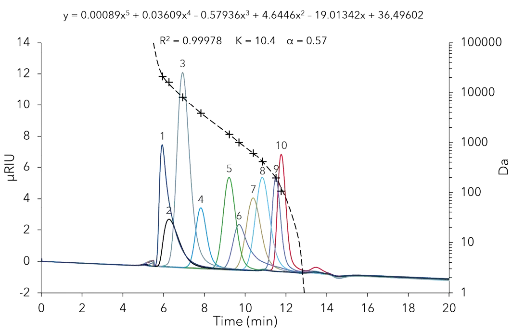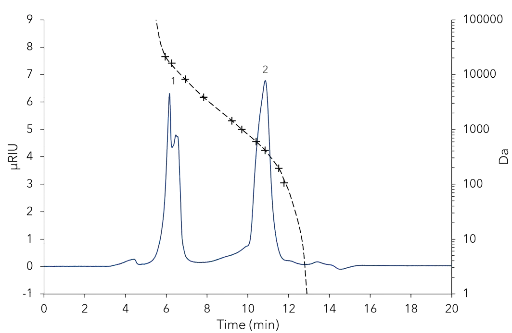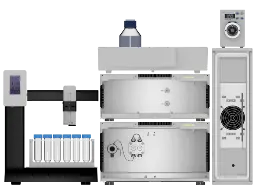
Science with Passion
Application No.: VBS0079
Version 1 03/2021
Characterization of fructans in fermentation products with GPC/SEC
Johannes Menke, Yannick Krauke, Kate Monks; applications@knauer.net
KNAUER Wissenschaftliche Geräte GmbH, Hegauer Weg 38, 14163 Berlin
Stanislav Parsin, Technische Universität Hamburg
Summary
Recent efforts to improve the efficiency of biorefineries aim to take advantage of otherwise discarded side products. In this application, a sample of biotechnological origin from cup plant (Silphium perfoliatum) was characterized in regards of the distribution of fructan polymers and other sugar contents. This was achieved using size exclusion chromatography (SEC) in combination with refractive index detection (RID). Next, the method was scaled up to a semi-preparative dimension in order to separate oligomers from monomers.
Introduction
In many cases one of the last steps of a biotechnological process is the purification of target compounds with some form of LC process. Meanwhile, during the production phase, a process control is needed as well. Therefore, in many cases LC is applied in one or another form in biotechnological processes. Samples or products originating from a biotechnological process based on cup plant (Silphium perfoliatum) [1] stems are expected to contain fructans in various length amongst other sugars and monomers [2]. A qualitative characterization was performed using size exclusion chromatography (SEC) in combination with refractive index (RI) detection. The sample was determined in regards of molecular weight distribution. A universal calibration with polyethylenglycol (PEG) standards was used to determine if the sample contained molecules in the molecular weight range of the expected fructans. The method was scaled up to a semi-preparative dimension to isolate the fructan oligomer fraction from the lower molecular sugars. Furthermore, the preparative experiments were used to evaluate the feasibility to apply continuous counter current LC process, respectively simulated moving bed chromatography (SMB). For these processes, a binary separation is needed.
Results
The universal calibration was successfully established. The calibration curve, a polynomic function of fifth order was fitted to the ten measurements with a coefficient of determination R² of 0.99978 using Mark-Houwink parameters of K=10.4 and α=0.57 (Fig. 1).

Fig. 1 Calibration overlay of single standards. 50 µl injection volume, flowrate 1 ml/min, 25 °C. 1 - MP21160, 2 - MP16100, 3 - MP8160, 4 - MP3860, 5 - MP1450, 6 - MP1010, 7 - MP610, 8 - MP410, 9 - MP194, 10 - MP106.
Therefore, in the following experiments substances with a molecular weight between 106 Da and 21 160 Da could be determined. The stationary phase AppliChrom ABOA-SuperOH-P with 7 µm particle size and a porosity of 250 Å was chosen since it is optimal for aqueous separations. This size exclusion phase can be used for analytes up to a molecular weight of 70 000 Da. The bulk material is a hydrophilic polymer, that is stable in a range of pH 2.5 – 12 and can withstand pressures up to 80 bar as well as temperatures from 10 to 85 °C. The sample was analysed using 50 µl of an 1:20 dilution. At a flow rate of 1 ml/min and a temperature of 25 °C a sufficient separation of the oligomers (Peak 1) and low molecular sugars (mono-, di-, trimers) (Peak 2) was achieved (Fig. 2).

Fig. 2 Sample on analytical system with 8 mm ID column. 50 µl injection volume, 1:20 dilution, flow rate 1 ml/min, temperature 25 °C. 1 - Fructan sized molecules (oligomers ~112 units), 2 - Low molecular sugars.
The oligomer peak was determined with an average molecular weight of 20 247 Da. From this result an approximate chain length of 112 units can be derived based on the molecular weight of monomeric fructose (MW 180.16 Da). The method was scaled up to semi-preparative scale using the KNAUER ScaleUp Converter software (A1696). Keeping the column length and particle size constant, a linear up-scale (although not true linear due to the precolumn with a length of 50 mm) by increasing the column inner diameter (8 mm ID to 20 mm ID) and the flow rate (1 ml/min to 7 ml/min) was possible. For the preparative experiments, 200 µl of the undiluted sample were injected. The results showed a sufficient resolution between oligomeric and low molecular sugars (Fig. 3). For fractionation of the sample, the chromatogram was sliced into 7.5 ml fractions using a fraction collector. Fractions of interest were analysed with the analytical system. The fractions F6 and F7, that were expected to contain the target substances, proofed to contain mainly oligomers. F6 showed a higher purity than F7 (Fig. 4).
Results

Sample in semi-preparative scale with 20 mm ID column. 200 µl injection volume, undiluted, flow rate 7 ml/min, temperature 25 °C. 1 - Fructan sized molecules (oligomers ~112 units), 2 - Low molecular sugars.

Fraction analysis on analytical system. 100 µl injection volume, undiluted, flow rate 1 ml/min, temperature 25 °C.
Sample preparations
For universal calibration, a PEG narrow standard kit from Agilent with ten standards was used. A series of ten standards was prepared with a range of molecular weights Mp of 106, 194, 410, 610, 1 010, 1 450, 3 860, 8 160, 16 100 and 21 160 Da. For that purpose, from each standard a 0.1 % solution (w/v) was prepared using distilled water. The frozen process sample, stored at -20 °C, was thawed at room temperature. Following, 15 ml of the sample were centrifuged at 10 000 g for 30 minutes at room temperature. The supernatant was decanted and the pellet discarded. The supernatant was filtrated using a membrane out of regenerated cellulose (RC) with a pore size of 0.45 µm. For preparative use, the sample was injection ready, for analytical determination several dilutions (1:10, 1:20, 1:50, 1:100) were prepared using distilled water.
Conclusion
SEC was effectively used on a fructan containing sample to separate oligo- from low molecular sugars. Using the described analytical method, a qualitative analysis regarding molecule size can be provided. The RI detection is robust and sensible enough to detect the sugar signals. The universal calibration can easily be adapted to other samples with different analytes/solvents, changing the Mark-Houwink parameters K and α according to literature (e.g. polymer handbooks) or using parameters suggested by the ClarityChrom software. Another option to optimize the approximation of the molecular weights would be to choose standard substances with a hydrodynamic radius closer to the analytes. Scaling up the process was easily achieved using the KNAUER ScaleUp Converter software [3]. The fractionation showed that oligomers (F6 and F7) were successfully isolated from the lower molecular sugars/components (F8 and F9). In preparative scale, the resolution between the oligomeric and low molecular fraction was sufficient to enable an SMB development process, as the sample was separated into a binary mixture. Although SEC has some disadvantages for preparative prufication, such as smaller loading volumes and lower flow rates compared to silica based stationary phases, the strict size-based separation is its main advantage for the given separation task.
References
Mayr, J., von Gehren, P., Gansberger, M., Hösch, J., Liebhard, P., Montgomery, L., Pachinger, B., Gautam, I. The potential of the energy crop Silphium perfoliatum L.. 23rd European Biomass Conference and Exhibition, Vienna, Austria (2015).
Pollock, C.J., Chatterton, N.J.. Fructans. In: Stumpf, P.K. and Conn, E.E. The Biochemistry of Plants: A Comprehensive Treatise. 14/109-140, Academic Press, Inc. (2012).
[3] KNAUER ScaleUp Converter.
https://www.knauer.net/software-hplc-method-converter.
Materials and Methods
Tab. 1 Method parameters – Analytical HPLC
Column temperature | 25 °C |
Injection volume | 50 µl |
Injection mode | Partial loop |
Detection | RI |
Detector temperature | 35 °C |
Data rate | 10 Hz |
Eluent | Water |
Flow rate | 1 ml/min |
Pump program | Isocratic |
Tab. 2 System configuration – Analytical HPLC
Instrument | Description | Article No. |
Pump | AZURA P6.1L, isocratic | |
Autosampler | AZURA AS 6.1L | |
Detector | AZURA RID 2.1L | |
Thermostat | AZURA CT 2.1 | |
Column | AppliChrom ABOA SuperOH-P-250 300x8 mm, ID 7 µ, 100 – 70 000 Da | |
Column | AppliChrom ABOA SuperOH-P-250 50x8 mm, ID 7 µ, 100 – 70 000 Da pre-column | |
Tubing | K-Connect 0.18 mm ID | |
Software | ClarityChrom 8.2.3 station | |
Software | ClarityChrom 8.2.3 SEC/GPC extension | |
Software | KNAUER ScaleUp Converter |

Tab. 3 Method parameters – Preparative HPLC
Column temperature | 25 °C |
Injection volume | 200 µl |
Injection mode | Full loop |
Detection | RI |
Detector temperature | 35 °C |
Data rate | 2 Hz |
Eluent | Water |
Flow rate | 7 ml/min |
Pump program | Isocratic |
Fractionation | 7.5 ml slices, time-based |
Tab. 4 System configuration – Preparative HPLC
Instrument | Description | Article No. |
Pump | AZURA P6.1L, isocratic 50 ml pump head sst | |
Valve drive | AZURA Valve Unifier VU 4.1 | |
Valve | 2-position valve with 6 ports | |
Detector | AZURA RID 2.1L high flow | |
Thermostat | AZURA CT 2.1 | |
Column | AppliChrom ABOA SuperOH-P-250 | Upon request |
Fraction Collector | Foxy R1 | |
Tubing | 0.5 mm ID PEEK | |
Software | ClarityChrom 8.2.3 station | |
Software | ClarityChrom 8.2.3 | |
Software | KNAUER ScaleUp Converter |

Related KNAUER Applications
VFD0172 – A D E K - Easy separation of fat-soluble vitamins using GPC/SEC
VBS0066 – Fast and sensitive size exclusion chromatography of IgG antibody
Application details
|
Method |
HPLC |
|
Mode |
GPC/SEC |
|
Substances |
Fructan polymers |
|
CAS number |
n/a |
|
Version |
Application No.: VBS0079 | Version 1 03/2021 | ©KNAUER Wissenschaftliche Geräte GmbH |


